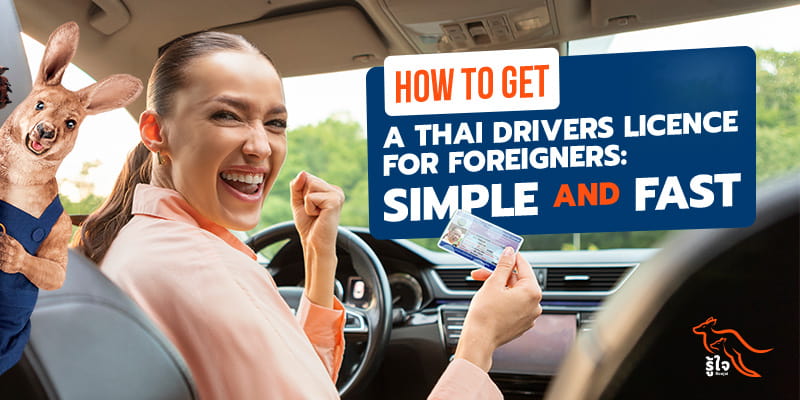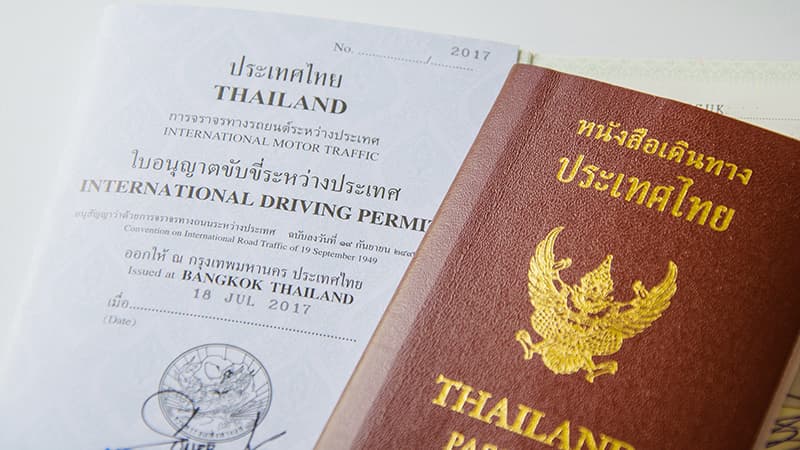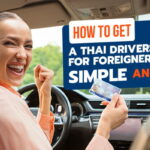
Starting a new life in Thailand is an exciting adventure, and for many, that includes the freedom of driving. However, navigating the process of getting a Thai driving license as a foreigner can seem intimidating. This guide will help you steer through the requirements and procedures, ensuring a smooth journey from application to approval. We’ll cover everything you need to know, including the necessary documents, tests, costs, and practical advice to make the process as straightforward as possible.
Why get a Thai driving licence?
Obtaining a Thai driving licence is essential for foreigners who plan to drive in Thailand. Driving without a valid licence can lead to fines and other legal issues. Here are the key legal requirements to be able to drive in Thailand:
- International driving permit (IDP): Foreigners can drive in Thailand with an IDP. However, an IDP is typically valid for one year from the issue date. It is important to note that while the IDP itself is valid for a year, its acceptance in Thailand may be limited to shorter stays, often up to 90 days.
- Thai driving licence: For long-term residents, having a Thai driving licence is mandatory. This ensures compliance with local laws and provides benefits such as recognized ID and full insurance coverage.
- Insurance coverage: Most insurance companies in Thailand require drivers to have a valid Thai driving licence or an IDP. Without it, you may not be covered in case of an accident, as car insurance policies typically mandate a valid driving licence for claims.
- Traffic regulations: Thailand has specific traffic rules, such as driving on the left side of the road and adhering to speed limits. A Thai driving licence ensures you are familiar with these regulations and can drive safely.
Having a Thai driving licence also serves as a widely accepted form of identification for hotel check-ins and police checks. It makes renting or buying a car in Thailand easier, saving money compared to using taxis or public transport. Additionally, a Thai driving licence is recognized in several ASEAN countries, simplifying travel in the region.
Requirements to obtain a Thai driving licence
Foreigners looking to get a Thai driving licence must gather a few important documents. Having all the required paperwork ready will help streamline the application process and make it more efficient. Below is a list of the essential documents you will need. Make sure to submit both the original and a photocopy of each document.
- Application form: Downloadable from the Department of Land Transport (DLT) website or available at the DLT office. The form is in Thai, so consider asking a local Thai speaker for assistance or using a translation app to help you fill it out.
- Passport: A valid passport is required as proof of identity and nationality.
- Visa: You must have a valid visa that allows you to stay in Thailand. This could be a tourist visa, non-immigrant visa, or any other visa type that permits a longer stay.
- Residence certificate: This certificate proves your address in Thailand. You can obtain it from the Immigration Bureau or your embassy. Alternatively, a work permit that includes your address can also serve this purpose.
- Medical certificate: A medical certificate from a Thai hospital or clinic is required to confirm that you are physically fit to drive. The certificate should be issued within the last 30 days before your application.
- IDP or home country driving licence (optional): While not mandatory, having an international driving licence or a driving licence from your home country can be beneficial. It may exempt you from some parts of the driving test, depending on the regulations at the DLT.
Eligibility criteria for foreigners
To be eligible for a Thai driving licence, foreigners must meet several criteria. Here are the key eligibility requirements:
- Age requirement: You must be at least 18 years old for a car driving licence and at least 15 years old for a motorcycle licence.
- Physical and mental fitness: You must be physically and mentally fit to drive. This is usually confirmed through a medical certificate from a Thai hospital or clinic.
- Driving tests: You must pass both the written and practical driving tests. Attending a driving school can help you prepare for these tests. If you already have a licence and just want to convert it to a Thai licence, you can skip the written and practical tests and only do the physical tests.
- Language proficiency: While not always mandatory, having a basic understanding of Thai can be beneficial, especially for the written test and understanding road signs.
- Knowledge of Thai traffic laws: Familiarity with Thai traffic laws and regulations is crucial. This includes understanding road signs, speed limits, and driving etiquette in Thailand.
- Financial preparedness: Be prepared to pay the necessary fees for the application, medical certificate, and any additional costs such as driving school fees.

Step-by-step process to apply for a Thai driving licence
1. Visit the DLT office
Locate your nearest DLT office using online maps or the official DLT website. Arrive early to avoid long queues. Alternatively, you can also book an appointment in advance with the DLT Smart Queue website or app. DLT offices are usually open from Monday to Friday, 8:30 AM to 4:30 PM. Bring snacks or water if you anticipate a long wait.
2. Submit your documents
At the DLT office, submit all the required documents. Ensure that you have photocopies of each document along with the originals. The staff will verify your documents and guide you through the next steps.
3. Attend the orientation session
You will be required to attend an orientation session, either online or in person, that covers Thai traffic laws, road signs, and safe driving practices. This session usually lasts a few hours and is typically conducted in Thai, but some offices may offer it in English or provide translation services.
4. Take the physical test
Before proceeding to the written test, you will undergo a vision test to check your eyesight to test for colour blindness, peripheral vision, reflexes, and depth perception. This is a quick test conducted at the DLT office.
5. Take the written test
The written test assesses your knowledge of Thai traffic laws and road signs. The test is available in multiple languages, including English. It consists of multiple-choice questions, and you need to score at least 45 out of 50 to pass.
6. Attend the practical training
If you pass the written test, you will need to attend a practical training session. This session includes instructions on basic driving manoeuvres and safety practices. It’s designed to prepare you for the practical driving test.
7. Take the practical driving test
The practical driving test evaluates your driving skills. You will be required to demonstrate various manoeuvres such as parking, turning, and emergency stops. The test is conducted on a designated driving course at the DLT office.
8. Pay the licence fee
Once you pass the practical driving test, you will need to pay the licence fee. The fee varies depending on the type of licence you are applying for. For a two-year temporary licence, the fee is approximately THB 205, while a five-year licence costs around THB 505. Motorcycle licences are even cheaper, costing about THB 105.
9. Receive your Thai driving licence
After paying the fee, you will receive your Thai driving licence. Initially, you will be issued a temporary licence valid for two years. After this period, you can renew it for a five-year licence. The renewal process involves submitting your current licence, passport, visa, work permit or residence certificate, and medical certificate to the DLT. If you have a digital work permit, you will need a certificate of residence from the Immigration Bureau or your embassy.
Succeeding in the driving test
To obtain a Thai driving licence as a foreigner, you must pass both a theory and a practical test. The theory test assesses your knowledge of Thai traffic laws, road signs, and safe driving practices. Topics covered include traffic laws, various road signs (warning, regulatory, and informational), and safe driving practices such as defensive driving techniques and speed limits. To prepare, use the official DLT handbook and online practice resources.
The practical test evaluates your driving skills and ability to handle a vehicle safely. Conducted on a designated driving course at the DLT office, you will need to demonstrate manoeuvres such as parking, turning, and emergency stops. To succeed, practice regularly, stay calm, and listen carefully to the examiner’s instructions.
Final thoughts
With this information, you’re now well-prepared to tackle the process of getting a Thai driving licence. Once you have your licence, don’t forget to secure the best car insurance to protect your investment. There are different types of car insurance in Thailand, including compulsory and voluntary insurance. Compare and get a quote with Roojai today in just 5 minutes!
Stay updated with the latest news, expat guides, insurance tips, and more by following Roojai on Facebook. You can also connect with us on LINE by adding our official ID: @roojai. Click here to add us as a friend!




